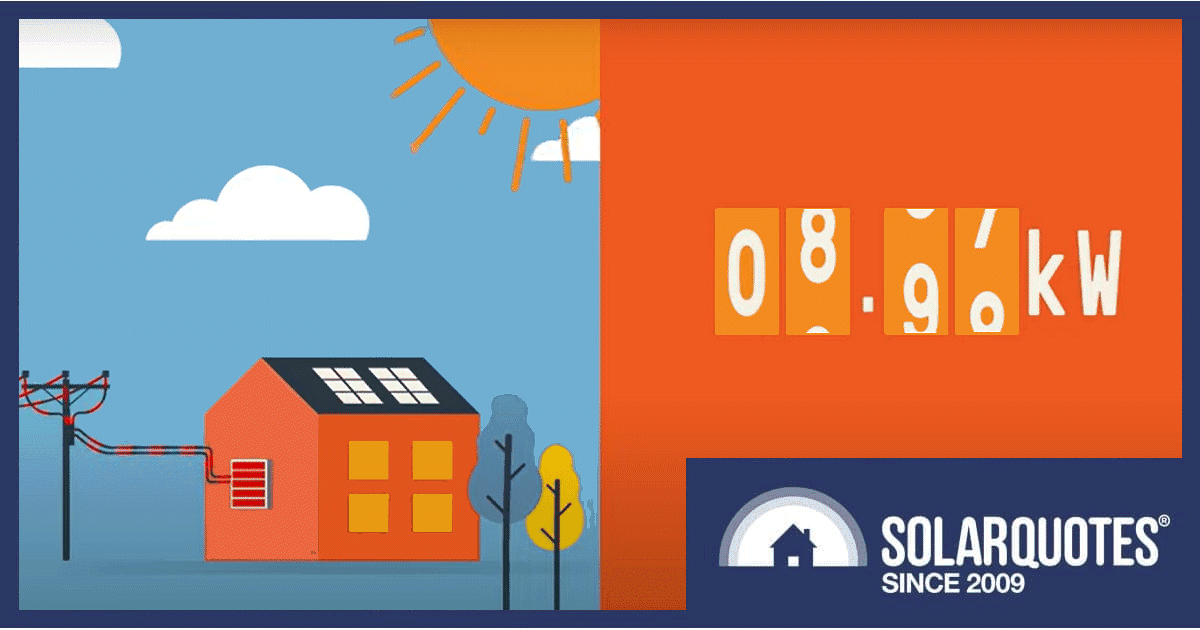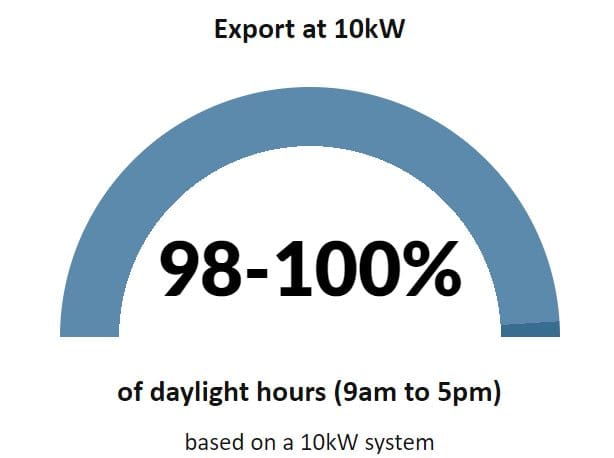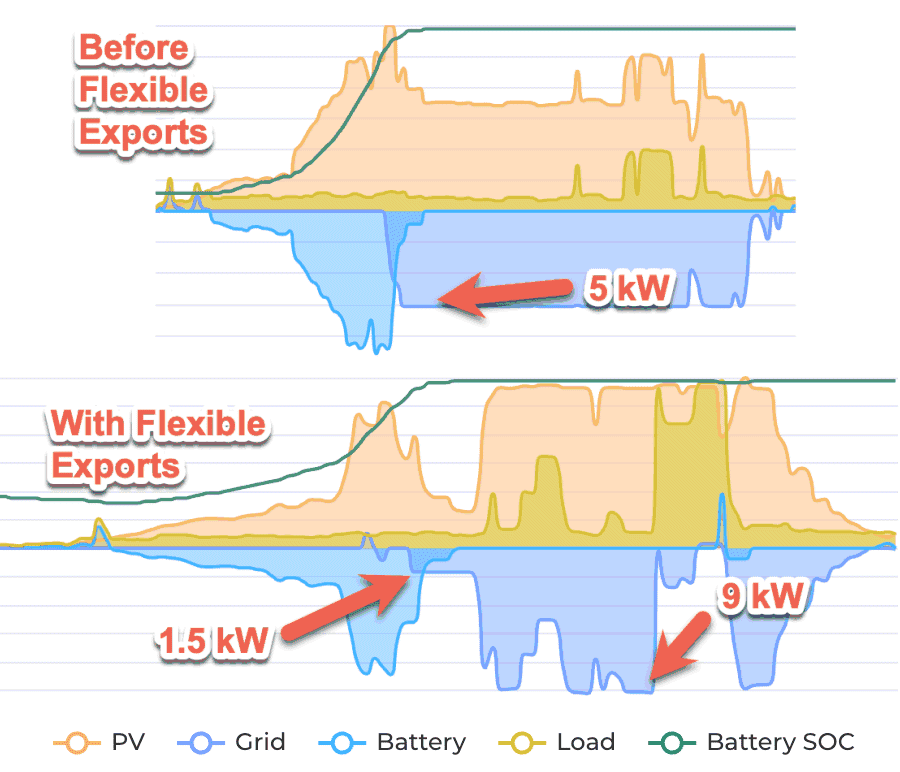
Owners of solar power systems in many more locations across South Australia recently became eligible for flexible exports. SolarQuotes’ Trevor took the plunge – and here’s what happened.
Hundreds of thousands of solar systems have been installed in SA, creating some management challenges for the state’s Distributed Network Service Provider (DNSP), SA Power Networks (SAPN).
Where uptake of solar panels is particularly high or the local electricity network not so robust, this can lead to network stability issues and other problems during periods of low electricity demand and elevated levels of surplus solar energy going into the grid. SAPN’s tool of last resort is remote disconnect/reconnect; but a more elegant approach is flexible (aka dynamic) exports.
In 2017, SAPN set an export limit of 5kW as standard. But new flexible exports allow for a much higher limit depending on network conditions on any particular day – up to 10 kW per phase. When there’s too much solar in the grid, exports will be automatically adjusted down so the network doesn’t overload, then adjusted back up when the situation passes. Signals setting the limit for whatever period are sent remotely to a system’s inverter (or compatible device), and all solar systems installed in South Australia since July 2023 have been required to be compatible with this functionality.
Flexible Exports Rollout Timeline
After a trial in 37 Adelaide suburbs experiencing congestion issues, SAPN started offering flexible exports more broadly through a staged rollout. This was initially 120 suburbs in July 2023, followed by another 200 locations last week – and with more to come. SAPN’s goal is to have flexible exports available across the state by the end of 2024 as a standard offering.
For New/Upgrading System Owners
In suburbs and towns where flexible exports are available, owners of new systems or existing systems being upgraded have a choice of either a reduced permanent fixed export limit of 1.5kW per phase or the flexible option (1.5kW – 10kW per phase). Your installer will submit the application on your behalf after a discussion with you about the options.
For Owners Of Existing Systems
Owners of existing solar systems can choose to do nothing and stay on what was previously the standard 5kW export limit – or make the switch to flexible exports via their installer; assuming the system is compatible and in an eligible area.
IMPORTANT: SAPN informed me if the owner of an existing system chooses to move onto flexible exports, they cannot revert to the 5kW standard limit at a later date. So, choose wisely.
To get a rough idea of the impact, you can check your address or National Meter Identifier (NMI) number against SAPN’s eligibility checker. This will provide an estimate based on your area’s performance over the last 12 months. In my case it shows I can expect to export at the full 10kW capacity 98% – 100% of the time if I had a system capable of doing so.
The 98% doesn’t mean that 2% of the time I may be exporting just 1.5kW. It means that 2% of the time it might not be the full 10kW, but it could be 8kW, or 9kW – or less of course.
SQ’s Trevor Takes The Flexible Exports Plunge
SolarQuotes’ General Manager Trevor wasted no time in making the switch. Trevor’s system specs:
- 42 x Jinko Solar panels: JKM475N-60HL4-V (total 19.95kW capacity)
- Sungrow inverter: SH10RS (10kW capacity)
- Sungrow battery: SBR128 (12.8kWh capacity)
It’s a big system1 as Trevor has two electric cars to charge from it – a BYD Atto 3 and a BYD Dolphin.
After receiving notification flexible exports were available in his suburb (he was on an SAPN notification list), Trevor’s first step was to get his installer, Deionno Electrical, to complete the necessary application for SAPN on his behalf. The good folks from Deionno then updated his inverter’s settings and awaited SAPN to complete testing.
The process was smooth and rapid. From the time Trevor contacted Deionno Electrical to when he received approval notification from SAPN was around 24 hours. And here’s how things looked during the first full day of flexible exports, compared to when he was on the 5kW limit.
Trevor said on this day, the 1.5 kW minimum lasted less than an hour and then it was pretty much 100% after that. As he has a 10 kW inverter, he’s not going to export much more than 9 kW at any given time.
The big test will be during mild and sunny days during spring when grid demand is low and solar exports are high. No doubt we’ll do a follow-up article in a few months’ time to see how Trevor’s travelling and to crunch some numbers.
Where South Australia has gone, other states will follow, so it’s worth keeping your finger on the pulse of what’s happening. Learn more about SAPN solar flexible exports here and sign up for the SolarQuotes newsletter here.
Footnotes
- Trevor funded this monster system purchase with CommBank’s Green Home Loan option. And on a related note, pick up some tips on financing a solar and/or battery system. ↩



 RSS - Posts
RSS - Posts



So,… If I had a 5kw of PV system with my 5kw existing export limit and wanted to increase the size of my solar array and put in a battery, should I just put in no export system to run ‘off grid” with a top up if needed late in the day based on what may be exporting from the original system, Would a catch solar relay help this to work?
The gov. just loves us so much that they prefer us to spend heaps of money for PV panels, batteries, inverters and EVs, so they can say we will achieve 82% VRE by 2030 – no! – it is only 65% as the other 17% we are carrying financially.
Hi Dominic,
Basically all of the legacy electricity generators & infrastructure were built by the government, we all carried them financially until a great number of them were handed over to shareholders for extraction of profit, like Northern power station in Port Augusta for instance.
The solar you bolt to your roof is primarily there to help you and being able to export energy is a happy coincidence that helps the entire network… not unlike publicly owned generation, except it’s distributed instead of being a large hub and spoke system.
This is a bit dated but it helps explain.
…what’s the reason why you cannot export 10kw with a 10kw inverter, in this example?…have you got a decent amount of appliances that constantly chews about 1kw?…we have a recently installed 10kw inverter & was looking forward to exporting 10kw, when we are eligible for Fexible exporting
Hamish, roughly speaking: yes.
The only time I get more than 10 kW out of the inverter is when I’m charging the DC-coupled battery.
I wish I had a DC-coupled EV charger…
Without a legend it took me a while to puzzle together the full meaning of the chart. I assume the pale blue is charging the battery? And orange the actual inverter output, that fluctuates in a way to keep exports below the limit, while allowing for self consumption (including charging the battery)?
If I got that right, I am surprised by the time of day the battery gets charged.
By charging it first thing in the morning, it wastes valuable export capacity (from a home owner’s perspective). It also means this system does not help the grid with its morning peak.
The battery should be charged at times when the inverter output would be curtailed due to export limits – to then shift that energy into the battery. In the “Before Flexible Exports” scenario that would have made a massive difference. In the “With flexible exports” scenario the difference might have been smaller, though it certainly would have meant the 1.5kW limit would have been a non-issue since at that time the battery could have soaked up the available excess.
Thanks, Peter. Michael’s going to add a legend.
I’m a simple man and just want my battery charged first. I’m happy with this arrangement, especially at this time of year when some days the battery doesn’t reach 100%!
I have an old Growatt 5000mtl with 6kW of panels that was there when we bought the house.
Since then, I’ve added another 6kW of panels and a new 5kW ESS inverter and battery. During last summer, we regularly exported up to the limit of 5kW and the Alpha monitoring showed up to 6.9kW exported on occasions.
The old inverter is obviously not compatible with flexible exports but the new one is.
I know it’s difficult as you have no idea how the systems are wired but do you have any idea how it would work for use to switch to flexible exports?
Hi Dave,
Simple answer is that your Growatt goes in the bin and you need a compatible inverter to replace it. Sadly that may mean you’re better off replacing the whole system to maintain a warranty though. We recently did a few articles on the subject.
https://www.solarquotes.com.au/blog/expanding-your-solar-pt1/
https://www.solarquotes.com.au/blog/upgrading-vintage-solar/
https://www.solarquotes.com.au/blog/winter-solar-upgrade/
https://www.solarquotes.com.au/blog/upgrade-modern-solar/